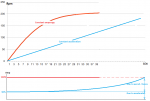I use a geared Denso starter off of a Toyota for a pre-rotator on The Predator with her thirty foot eight and a half inch chord Sport Rotors.
I do not have a soft start or a speed control.
Typically I see a little over a hundred rotor rpm in no wind conditions and I have been through four starters in over 2,000 takeoffs.
… in one very busy day I started the … the rotor 45 times.
I do not recommend a car starter for a pre-rotator. It is my understanding their duty cycle is six seconds and they make a lot of heat.
Maximum torque is at stall so a car starter is hard on the mast.
Godzilla reports just having fried her geared pre-ro starter motor yesterday. I sure hope Geoff can get it fixed before the Mentone Convention.
Vance, you thought from a photo I posted elsewhere it is the same motor you mentioned above, when I was posting that I didn't understand why it was wired with a switch marked "SOFT START" yet I could not get it to actually do a soft start. You replied that I "obviously needed to study to understand the basic principals of electricity and wiring" in a rather arrogant, dismissive way. I replied that I actually do know quite a bit about the topic, having studied electric physics at the University of Michigan, etc.
Some folks who have electric pro-ro's swear by them, like Barry Kroplin - whom we all had a good laugh at, at his expense, at Wrens one year watching as he tried in desperation to hand-start a set of Dragon Wings on a Wind Ryder after his electric starter burned out. He was done for the day, needless to say. I was saddened, I wanted to see that fancy gyrocopter fly!
I don't understand the love people have for these fussy electric motor pre-ro's. They are heavy and create a lot of weight on one side of the rotor head unnecessarily, for which you must add a trim spring opposite, and are far more time, trouble, maintenance, etc. They require a FAR heavier battery, many feet of very heavy copper cables, additional solenoid so you dont' have 600 amps of power running up the mast when not spinning up, and those darn solenoids burn out to - just like the motor
will, which is a matter of when, not if.
You write that you expect to replace one every 500 starts, and that on one busy day you used it 47 times. So in 11 busy days you will be replacing the starter motor.
That's a lot of time, down time, and cash down the toidy.
Mechanical pro-ros are far less maintenance, very little side-heavy head weight, no worry and in the end far less expense. Oh, well. Good to know they can spin up your 30" rotor to 100 or 120 RRPMs. I mean, that's
it?
The mechanical pre-ro's I've had experience spin up even heavy Sky Wheels, 28", to 180 RRPM using a somewhat poor-efficiency Wunderlich flex shaft and a flat belt PTO. After that, the belt slips and creates heat, causing the belt to warp as it cools after spin up. With a wider PTO belt I'm sure I could easily hit 200 RRPM, which is what MTO and other far more efficient shaft PTO's see routinely.
The electric PTO seems such a dumb system.
I see absolutely no advantage - and in fact many disadvantages - to electric pre-ro.
You literally
could not give me one, much as the nice fellow in FLA who tried to
give me a good Subaru with redrive, all in excellent condition. I humbly and kindly refused his offer. To me it is a waste of time and hanger space, just so much junk that I wouldn't even want to be bothered with trying to sell it.
That's just my opinion, formed after much observation and some personal experience over the past 15 years, a rather short time actually.
But to each his own, I say. "Whatever floats yer boat" - or in our case, gets you in the air.



